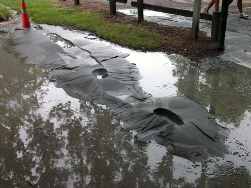
Twenty-nine Nottingham geologists on a 'geotour' holiday were caught up in the 6.3 Mw earthquake in Christchurch. Dave Wilson* tells his story.
Geoscientist 20.05 June 2011
It was the last day. Suitcases packed, we were killing time before our flight. It was raining so when the earthquake struck I was on the top floor of the Canterbury Museum, examining an exhibition devoted to a centenary of Antarctic exploration. There was no warning; no build-up in the intensity of tremors, just one enormous bang and a terrific lurch followed immediately by a series of violent jolts that went on for about 15 seconds before subsiding.
GET ME OUT OF HERE
We were flung across the room. Lights went out and alarms sounded. I realised it was an earthquake almost immediately (we'd seen the effects of the September event the previous day), and made for the exit; but the tremors made it difficult to keep our feet and run in a straight line. Tables, glass and crockery crashed to the ground in the restaurant, as people headed for the stairs and emergency exit.
Once outside we moved away from the building. Fortunately the museum backs onto the open space of Christchurch Botanic Gardens, although even here it was not entirely safe as branches fell from trees; in other parts of the gardens whole trees were uprooted.
By this time we were joined by a flood of people from Christchurch central business district (about a quarter of a mile away). Aftershocks came and went every ten minutes or so, some almost as strong as the original. Files of schoolchildren arrived (they all get earthquake drill at school) and walking wounded, many visibly shocked, on their way to the hospital. Eventually about 1500 people gathered, telling how shops, offices and the Cathedral had collapsed, and how people had been trapped.